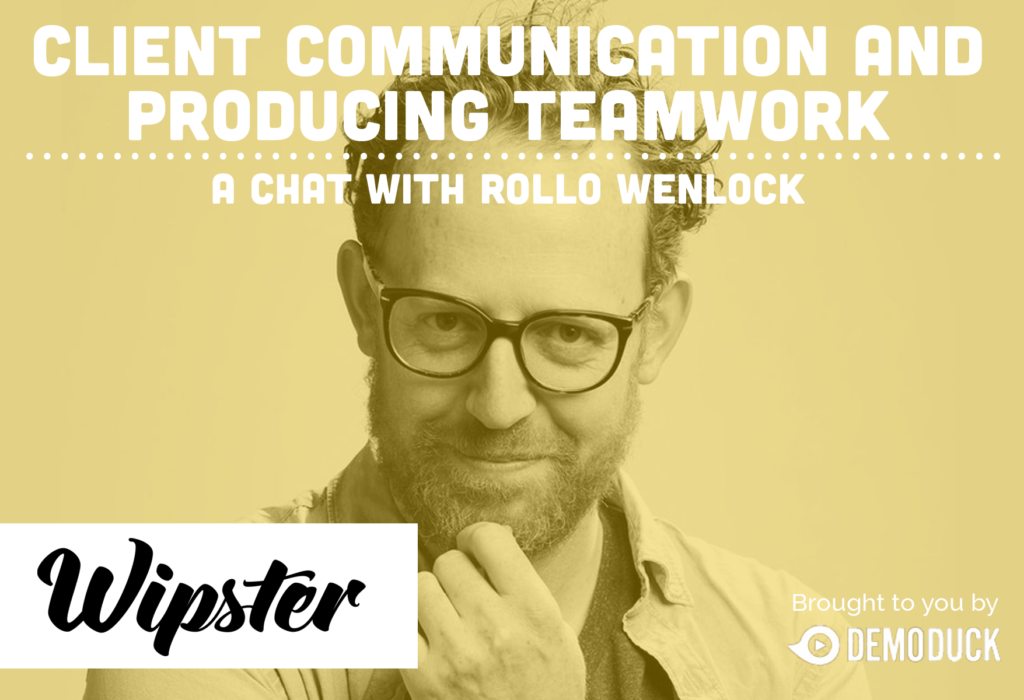
Recently, we were lucky enough to sit down with Rollo Wenlock of New Zealand based Wipster to chat about working with clients and using technology to create better videos. Here are some highlights of that conversation.
Why did you start Wipster?
I’ve been a professional video producer for 15 years, so I’ve been in the world of moving pictures for quite some time. The real pain point occurred when I was working with an agency and doing a TV commercial in another city. So, we had this big client and we were feeling good about the project but the only way I could get work to them was either a Vimeo password protected link or a Dropbox folder. We shot on a 4K camera and footage would get compressed and ruined when they watched it within the Dropbox interface. There just wasn’t anything magical about it.
Then when the client wanted to talk to you about the video, they’d have one guy write an email, try to throw everyone’s feedback in it, and include some vague timestamps. The whole process just made me depressed. Making videos is joyful, but the entity that was paying for that video to be made, usually the client, wasn’t having a joyful experience.
Making videos is joyful, but the entity that was paying for that video to be made, usually the client, wasn’t having a joyful experience.
They would start to feel subconsciously depressed about the company they’re working with. This process also made it less viable to work with companies that aren’t in the same town and efficiency went out the window. The whole thing was so gross.
Some frustrations there that I think most video producers can relate to. How did the idea for Wipster come to be?
So one day, soon after my daughter was born, I was up very early in the morning and was looking through my window. It happened to have a lot of dust, it’s very hard to reach by the way, and the sun exposed all the dust on the window. I noticed this dust created an additional layer on top of the view out the window that someone could actually draw on. At that moment I went, “Boom! Why don’t we create videos where all the communication of ideas is on top of the video?” That was the kernel of the idea and has been the genesis of everything Wipster has done thus far.
That sounds magical! As a feedback expert, what are some best practices for clients and customers when it comes to revisions?
The really huge thing that people leave out, is setting a schedule and making clients accountable to that schedule. What a lot of video production companies are afraid of is dictating to the client what they are responsible for in the process. It’s a partnership. So, people are really soft around due dates of reviews or even putting a schedule together at all.
What happens is the production company only uses a few key dates for the project, they loop in the client at various, random times, and they start to forget about gaining new business too. So, at the end of the project, everyone may be sort of satisfied but the production company ends up without another project lined up and nothing to work on. So, scheduling is definitely number one.
What’s the best way to approach scheduling?
You need to schedule everything down to the hour and get the client to sign off on it. If they don’t, you probably don’t want to work with that client. When you give them a specific time for when a revision is due, you need to hold them to that. If that time comes and goes, then it’s over…they missed that round of revisions and you move on to the next step in the process. If they need an extra day, you charge them for it. It sounds harsh, but that’s how rigid you need to be. You need to run your business. For video producers, 50% of your job is to create a video the client likes and 50% is to run your business well.
Where do you see corporate and business video going in the future?
Most of the projects production companies are currently working on are corporate videos of some sort and I think the video production companies that just make a video then hand it off to the client are going to go away. The ones that understand their client’s goals and develop a product that will help them achieve those goals, will be better positioned for long-term success.

There are even some companies that are attaching some component of their payment to how the video performs compared to the goals laid out at the beginning of the partnership. So, this gives them the chance to earn a lot more money than they would have gotten for a flat rate. It’s scary but the companies that are going to win are the ones that have a strategy around what their clients want the video to do. As a product, Wipster wants to help companies achieve their goals and we’re developing the technology to be more campaign based and built for these longer term relationships.
How will all of that impact video marketing and properly engaging audiences?
The trend of video consumption is just insane. The barrier to entry into an effective video marketing campaign is going to go up. You used to be able to put one video on your homepage and be done with it. Then you needed a new video every month. Soon, it will be a new video every week. Eventually, you’ll need your own TV channel.
What people expect in terms of content will continue to evolve too. Quality will be judged by the storytelling and personality, rather than how great the video looks. So be sure to properly execute on both quantity and quality.
I have no idea what time it is there, but it’s either really late or really early. So, anything else you wanted to add before I let you go back to bed?
Our product is really aimed at teams working together. So if you have a video production company with a couple of editors, producers, designers, and more – the customers of ours that really succeed provide a lot of visibility to their entire team. They tend to use Wipster as a place where everyone can see how their work affects the bigger picture, and what everyone is saying about that picture. So, don’t focus on having better communication with just your client. Transparency across your own team is just as important.
We think it’s valuable to move your production into the cloud so that everyone is up to date with everyone else. It just makes the process so much faster and creates a better experience for everyone.
